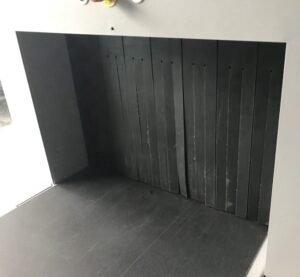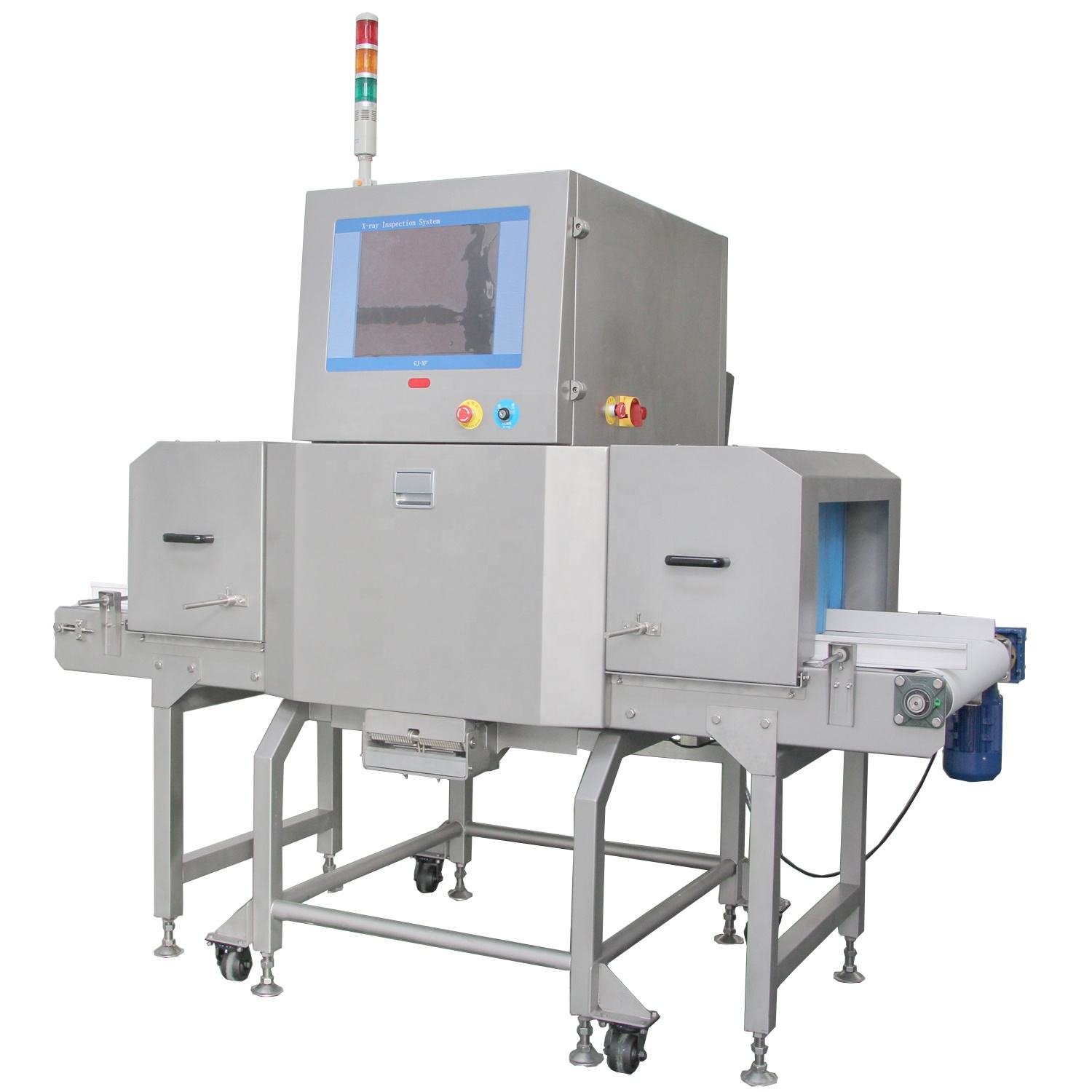introduction
X-ray inspection equipment is an essential tool in various industries, providing a non-destructive method of examining the internal structure of objects. These machines use X-rays, a form of electromagnetic radiation, to penetrate materials and reveal hidden details.
Types of X-ray inspection machines
There are different types of X-ray inspection equipment designed for specific applications. These include:
Cabinet X-ray machines: For inspecting small to medium sized objects such as luggage, packages and electronics.

Conveyor belt X-ray machines: Ideal for inspecting large quantities of products on a conveyor belt, such as food, pharmaceuticals and industrial goods.
Mobile X-ray machines: These portable and lightweight devices are used for on-site inspections, for example in the construction industry or in law enforcement.

How X-ray inspection machines work
X-ray inspection machines emit X-rays that penetrate the object being inspected. Denser materials absorb more X-rays, while less dense materials allow them to pass through more easily. The resulting X-ray image shows the internal structure of the object and highlights any anomalies or defects.
Advanced features of X-ray inspection machines

In addition to their core functionality, modern X-ray inspection machines are equipped with a number of advanced features that enhance their performance and versatility.
High-resolution imaging
Modern X-ray inspection machines use high-resolution detectors to capture detailed images of objects. This allows even the smallest defects, foreign bodies and structural anomalies to be detected. The resulting images provide a comprehensive overview of the internal composition and enable thorough analysis and quality control.
3D reconstruction
Modern X-ray inspection machines offer 3D reconstruction capabilities that provide a virtual representation of the scanned object. This feature allows users to rotate and manipulate the 3D model, gaining a comprehensive understanding of the object's internal structure. This is especially useful for complex objects with complicated geometries.
Substantial discrimination
Modern X-ray inspection equipment can distinguish different materials based on their density and atomic number. This feature allows the identification of specific materials in an object, such as metals, plastics and organics. It is crucial for applications where material composition is crucial, for example in the food and pharmaceutical industries.
Automated error detection
Advanced X-ray inspection equipment has automated defect detection algorithms that analyze images and identify potential defects. These algorithms are trained on large data sets, allowing them to detect a wide range of anomalies with high accuracy. This feature significantly reduces the time and effort required for manual inspection and improves efficiency and reliability.
Image enhancement
X-ray inspection equipment offers a range of image enhancement techniques that improve the visibility of specific features. These techniques include contrast adjustment, noise reduction, and edge enhancement. By optimizing image quality, users can more easily identify defects and other areas of interest.
Connectivity and data management
Modern x-ray inspection machines are equipped with advanced connectivity capabilities, allowing them to be integrated into larger inspection systems and networks. They can also generate and store inspection data that can be used for quality control, traceability and reporting purposes. These connectivity and data management features improve the overall efficiency and effectiveness of the inspection process.
Applications of X-ray inspection machines
X-ray inspection machines have a wide range of applications, including:
Security check : Detecting weapons, explosives and contraband in luggage, packages and vehicles.
Quality control: Inspection of products for defects, contamination and foreign bodies.
Medical imaging: Diagnosis of diseases by examining bones, organs and tissues.
archeology : Study of ancient artifacts and fossils.
Industrial inspection: Inspection of welds, castings and other industrial components for defects.
Benefits of using X-ray inspection machines in different industries
In manufacturing, X-ray inspection equipment plays a critical role in quality control. It can detect internal defects such as cracks, voids and inclusions that can compromise the integrity of the product. By detecting these defects early, manufacturers can prevent defective products from reaching the market, reducing the risk of recalls and liability.
The food and beverage industry also benefits greatly from x-ray inspection machines. These machines can detect foreign objects such as metal fragments, broken glass and stones that can pose a serious health risk to consumers. By ensuring the safety and quality of food, x-ray inspection machines help protect consumers and maintain brand reputation.
In the pharmaceutical industry, X-ray inspection machines are used to check the integrity of tablets, capsules and other dosage forms. They can detect missing or broken tablets, as well as foreign objects that may have entered during the manufacturing process, ensuring that patients receive safe and effective medications.
The aerospace industry relies on X-ray inspection equipment to ensure the safety and reliability of aircraft components. These devices can detect hidden cracks, corrosion, and other defects that could compromise the structural integrity of the aircraft. By detecting these defects early, manufacturers can prevent catastrophic failures and ensure the safety of passengers and crew.
In the security field, X-ray scanners are used to examine baggage, packages and other items for potential threats. They can detect weapons, explosives and other contraband, helping to prevent terrorist attacks and other security breaches.
The benefits of X-ray inspection equipment extend far beyond these industries. They are also used in the automotive, electronics and construction industries, among others. Thanks to the non-destructive and high-precision testing method, X-ray inspection equipment helps to ensure the quality, safety and reliability of products in a wide range of applications.
How to choose the right X-ray inspection device for your needs
X-ray inspection equipment is an essential tool for ensuring the safety and quality of products in various industries. Whether you are inspecting food, pharmaceuticals or electronics, choosing the right equipment is critical for optimal performance. Here is a comprehensive guide to help you make an informed decision:
- Determine your inspection needs:
Start by identifying the specific needs of your inspection process. Consider the size, shape and density of the products to be inspected. Determine the level of detail and sensitivity needed to detect defects or contamination.
- Consider the type of X-ray technology:
There are two main types of x-ray inspection equipment: single-view and dual-view. Single-view equipment provides a 2D image of the product, while dual-view equipment provides a more comprehensive 3D view. Dual-view equipment is ideal for inspecting complex or dense products.
- Rate the image quality:
The image quality of the X-ray machine is of utmost importance. Look for machines that produce high-resolution images with minimal noise and distortion. This will ensure accurate defect detection and reduce false alarms.
- Determine the inspection speed:
Inspection speed is critical to maintaining productivity. Consider the throughput requirements of your production line and choose a machine that can meet or exceed them. High-speed machines are ideal for fast-paced environments.
- Consider the software features:
The software that powers the X-ray machine plays a crucial role in its functionality. Look for machines with user-friendly software that offers advanced features such as image enhancement, defect detection algorithms, and data logging.
- Evaluate the security features:
X-ray machines emit radiation, so safety is of the utmost importance. Make sure the machine meets all applicable safety standards and regulations. Look for machines with built-in safety features such as radiation shields and interlocks.
- Consider maintenance and support:
Regular maintenance is essential for optimal performance and longevity of the X-ray machine. Choose a machine from a reputable manufacturer that offers reliable maintenance and support services.
- Evaluate the costs and return on investment:
The cost of the X-ray machine is an important factor, but it is equally important to consider the return on investment. A high-quality machine with advanced features may have a higher initial cost, but it can save you money in the long run by reducing downtime and improving product quality.
Following these guidelines will help you choose the right x-ray inspection machine to meet your specific needs and ensure the safety and quality of your products. Remember to consult industry experts and manufacturers for personalized recommendations based on your individual requirements.
Troubleshooting common problems with X-ray inspection equipment
X-ray inspection machines are essential tools for safety and quality control in various industries. However, as with all complex equipment, problems can occasionally arise that prevent them from performing optimally. Here are some common problems and the corresponding troubleshooting steps:
- Bad picture quality
- Cause: Dirty or damaged X-ray tube or detector.
- Solution: Clean or replace the affected components.
- Cause: Incorrect exposure settings.
- Solution: Adjust exposure time, voltage and current to optimize image quality.
- System crashes
- Cause: Software error or hardware malfunction.
- Solution: Restart the system and check for software updates. If the problem persists, contact the manufacturer for technical support.
- Tape jams
- Cause: Foreign objects or deposits stuck in the conveyor belt.
- Solution: Remove the blockage and clean the belt. Make sure the belt is properly tensioned and aligned.
- False alarms
- Cause: Incorrect sensitivity setting or environmental interference.
- Solution: Adjust the sensitivity levels and check for external radiation sources that may cause false alarms.
- Problems with the power supply
- Cause: Faulty power supply or loose connections.
- Solution: Check the electrical supply and make sure all connections are tight. If the problem persists, contact a qualified electrician.
- Mechanical faults
- Cause: Worn or damaged mechanical components.
- Solution: Check the machine for loose or broken parts. Lubricate moving parts according to the manufacturer's instructions.
- Operating error
- Cause: Incorrect operation or handling of the machine.
- Solution: Make sure operators are properly trained and follow manufacturer guidelines.
preventive maintenance
To minimize the occurrence of these problems, regular preventative maintenance is essential. This includes:
- Cleaning and checking the X-ray tube and detector.
- Calibrate the system to ensure accurate measurements.
- Check and tighten all connections.
- Regularly update software and firmware.
By following these troubleshooting steps and implementing preventative maintenance practices, you can ensure that your x-ray inspection equipment performs optimally and delivers reliable, accurate results for years to come.
The future of X-ray inspection technology
X-ray inspection equipment has revolutionized the fields of security and quality control. These advanced devices use electromagnetic radiation to penetrate objects and reveal their internal structure and composition. As technology continues to advance, X-ray inspection equipment will play an even more important role in shaping the future.
One of the most significant advances in X-ray inspection technology is the development of dual-energy systems. These devices use two different X-ray energies to distinguish between materials of similar density. This capability improves the detection of contraband, explosives, and other threats in security applications. In addition, dual-energy systems can identify foreign objects and contaminants in food and pharmaceutical products, ensuring product safety and quality.
Another promising area of innovation is computed tomography (CT). CT machines rotate the object being examined and capture multiple X-ray images from different angles. This data is then reconstructed into a detailed 3D model that provides a comprehensive overview of the object's internal structure. CT scans are particularly useful in medical imaging, as they allow doctors to diagnose and treat diseases more precisely.
In addition, advances in image processing algorithms are improving the accuracy and efficiency of X-ray inspection equipment. Artificial intelligence (AI) and machine learning techniques can automatically detect anomalies and classify objects, reducing the need for manual inspection. This automation streamlines the inspection process and saves time and resources.
The future of X-ray inspection technology also holds great promise for non-destructive testing (NDT). Using X-rays to inspect materials and structures allows engineers to identify defects and assess their severity without damaging the object. This capability is critical in industries such as aerospace, automotive, and construction, as it ensures the safety and reliability of critical components.
Diploma

X-ray inspection equipment is a powerful tool that provides valuable insight into the internal structure of objects. Their versatility and reliability make them indispensable in various industries, from security screening to quality control to medical imaging. By understanding the operating principles, types, applications and safety considerations, you can effectively use X-ray inspection machines to improve your operations and ensure the safety of your personnel and products.
As technology advances, we can expect to see even more sophisticated and versatile systems that improve our ability to detect threats, ensure product safety, and advance scientific research. The future of X-ray inspection technology is bright, promising to revolutionize industry and improve our lives in countless ways.





